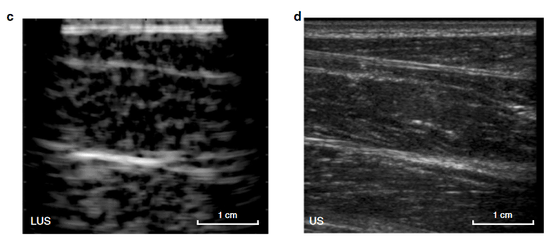Succeeded in developing a 'non-contact echo test' that images the inside of the body with laser irradiation

Full noncontact laser ultrasound: first human data | Light: Science & Applications
https://www.nature.com/articles/s41377-019-0229-8
Researchers produce first laser ultrasound images of humans | MIT News
http://news.mit.edu/2019/first-laser-ultrasound-images-humans-1219
Among techniques for imaging the human body, echo examinations do not use harmful radiation such as X-ray ( CT ) scans and CT scans, and are necessary for positron emission tomography (PET) and MRI examinations. Does not require large and expensive machinery. On the other hand, echo inspection has problems such as the need to apply a probe to the skin and the resulting images vary.
The MIT research team found that a 1550-nanometer-wavelength laser struck human skin and generated sound waves that were useful for echo testing. We developed a method of generating sound waves for measuring the inside of the body with the first laser and detecting the sound waves with the sound waves of the second laser. Below is how the laser is actually irradiating the arm.

The left side of the image below is an image generated by a new type of echo test using a newly developed laser, and the right side is an image of a conventional echo test for comparison.

At the stage of the announcement, the images generated by the new type of echo inspection using a laser are inferior in resolution to the conventional echo inspection. However, the research team stated that 'improvements are possible' and commented that 'the initial goal was exceeded'.
One promising new echo test using this laser is that no physical contact is required. Conventional echo testing requires the probe to be in contact with the skin, and has the drawback that it cannot be used for patients with burns, patients immediately after surgery, and infants. The newly developed new echo test using a laser can be used for all people.
The research team is also looking at the development of a portable echo inspection device by automating the inspection process of the newly developed echo inspection. 'We have a future in which we can automatically generate images of the inside of the body and record the state of the thyroid and arteries when we wake up in the morning,' said Brian Anthony, who led the research team.
Related Posts:
in Science, Posted by darkhorse_log







